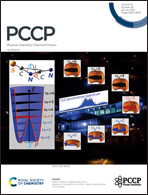Origin of the negative longitudinal piezoelectric effect and electric auxetic effect in hexagonal AIBIVCV semiconductors†
Abstract
Hexagonal ABC semiconductors with a polar structure are potential candidates for piezoelectric applications. The intriguing negative longitudinal piezoelectric effect (NLPE) and electric auxetic effect (EAE) may exist in these materials, and establishing the structure–property relation provides physical insights into the underlying mechanisms responsible for these phenomena. In this work, using first-principles calculations, we investigate the piezoelectric response in a class of hexagonal AIBIVCV (A = Li, Na, and K; B = Ge and Sn; C = N, P, As, and Sb) semiconductors. We demonstrate that the quasi-layered structure with contrasting interlayer and intralayer bonding strengths plays a crucial role in the longitudinal piezoelectric response. In this class of materials, we identify 11 compounds out of the 24 candidates possessing the NLPE. We find that the NLPE tends to occur when the quasi-layered structure is pronounced. Moreover, we identify an unusual coexistence of negative longitudinal and transverse piezoelectric responses, and hence the compounds possessing the NLPE are electric auxetic materials as well. This work provides a simple guide for the search of piezoelectrics with desired responses.



 Please wait while we load your content...
Please wait while we load your content...